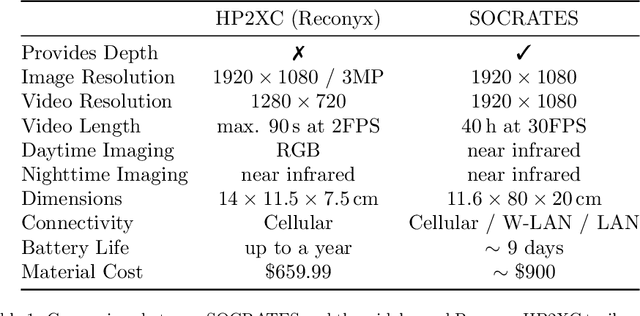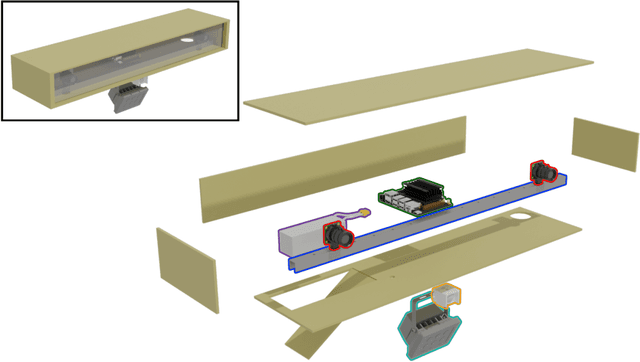Hjalmar Kühl
Towards Application-Specific Evaluation of Vision Models: Case Studies in Ecology and Biology
May 05, 2025Abstract:Computer vision methods have demonstrated considerable potential to streamline ecological and biological workflows, with a growing number of datasets and models becoming available to the research community. However, these resources focus predominantly on evaluation using machine learning metrics, with relatively little emphasis on how their application impacts downstream analysis. We argue that models should be evaluated using application-specific metrics that directly represent model performance in the context of its final use case. To support this argument, we present two disparate case studies: (1) estimating chimpanzee abundance and density with camera trap distance sampling when using a video-based behaviour classifier and (2) estimating head rotation in pigeons using a 3D posture estimator. We show that even models with strong machine learning performance (e.g., 87% mAP) can yield data that leads to discrepancies in abundance estimates compared to expert-derived data. Similarly, the highest-performing models for posture estimation do not produce the most accurate inferences of gaze direction in pigeons. Motivated by these findings, we call for researchers to integrate application-specific metrics in ecological/biological datasets, allowing for models to be benchmarked in the context of their downstream application and to facilitate better integration of models into application workflows.
The PanAf-FGBG Dataset: Understanding the Impact of Backgrounds in Wildlife Behaviour Recognition
Feb 28, 2025Abstract:Computer vision analysis of camera trap video footage is essential for wildlife conservation, as captured behaviours offer some of the earliest indicators of changes in population health. Recently, several high-impact animal behaviour datasets and methods have been introduced to encourage their use; however, the role of behaviour-correlated background information and its significant effect on out-of-distribution generalisation remain unexplored. In response, we present the PanAf-FGBG dataset, featuring 20 hours of wild chimpanzee behaviours, recorded at over 350 individual camera locations. Uniquely, it pairs every video with a chimpanzee (referred to as a foreground video) with a corresponding background video (with no chimpanzee) from the same camera location. We present two views of the dataset: one with overlapping camera locations and one with disjoint locations. This setup enables, for the first time, direct evaluation of in-distribution and out-of-distribution conditions, and for the impact of backgrounds on behaviour recognition models to be quantified. All clips come with rich behavioural annotations and metadata including unique camera IDs and detailed textual scene descriptions. Additionally, we establish several baselines and present a highly effective latent-space normalisation technique that boosts out-of-distribution performance by +5.42% mAP for convolutional and +3.75% mAP for transformer-based models. Finally, we provide an in-depth analysis on the role of backgrounds in out-of-distribution behaviour recognition, including the so far unexplored impact of background durations (i.e., the count of background frames within foreground videos).
Triple-stream Deep Metric Learning of Great Ape Behavioural Actions
Jan 06, 2023



Abstract:We propose the first metric learning system for the recognition of great ape behavioural actions. Our proposed triple stream embedding architecture works on camera trap videos taken directly in the wild and demonstrates that the utilisation of an explicit DensePose-C chimpanzee body part segmentation stream effectively complements traditional RGB appearance and optical flow streams. We evaluate system variants with different feature fusion techniques and long-tail recognition approaches. Results and ablations show performance improvements of ~12% in top-1 accuracy over previous results achieved on the PanAf-500 dataset containing 180,000 manually annotated frames across nine behavioural actions. Furthermore, we provide a qualitative analysis of our findings and augment the metric learning system with long-tail recognition techniques showing that average per class accuracy -- critical in the domain -- can be improved by ~23% compared to the literature on that dataset. Finally, since our embedding spaces are constructed as metric, we provide first data-driven visualisations of the great ape behavioural action spaces revealing emerging geometry and topology. We hope that the work sparks further interest in this vital application area of computer vision for the benefit of endangered great apes.
SOCRATES: A Stereo Camera Trap for Monitoring of Biodiversity
Sep 19, 2022



Abstract:The development and application of modern technology is an essential basis for the efficient monitoring of species in natural habitats and landscapes to trace the development of ecosystems, species communities, and populations, and to analyze reasons of changes. For estimating animal abundance using methods such as camera trap distance sampling, spatial information of natural habitats in terms of 3D (three-dimensional) measurements is crucial. Additionally, 3D information improves the accuracy of animal detection using camera trapping. This study presents a novel approach to 3D camera trapping featuring highly optimized hardware and software. This approach employs stereo vision to infer 3D information of natural habitats and is designated as StereO CameRA Trap for monitoring of biodivErSity (SOCRATES). A comprehensive evaluation of SOCRATES shows not only a $3.23\%$ improvement in animal detection (bounding box $\text{mAP}_{75}$) but also its superior applicability for estimating animal abundance using camera trap distance sampling. The software and documentation of SOCRATES is provided at https://github.com/timmh/socrates
 Add to Chrome
Add to Chrome Add to Firefox
Add to Firefox Add to Edge
Add to Edge